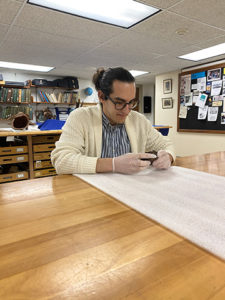2020 Ritzenthaler Museum Research Internship Award
Armando Manresa is the 2020 Ritzenthaler Museum Research Internship Award Recipient. This semester (Spring 2020), he began working with the Milwaukee Public Museum’s (MPM) collection of about 130 ceramic vessels that are fake, fraudulent, or reproductions from throughout Latin America. The artifacts were created to look identical to “authentic” pieces from pre-Columbian Latin America and were made for various reasons.

A small selection of the objects can be seen on exhibit on the MPM’s Third Floor Mezzanine, entitled “Fake and Fraudulent Artifacts”. This exhibit inspired Armando’s thesis topic. His research is focusing on the way that museums can identify these kinds of objects, why they were initially created, and how museums care for and interpret these types of items at their museum.
Prior to Armando starting his research, no one had worked on this collection at MPM. The lack of accurate records that MPM had in regard to this material only further complicated the task of compiling a list of viable artifacts for this thesis project. Due to the lack of museum recording- keeping during the early to middle 1900s the information that can be found pertaining to these objects is limited. This issue highlights one of the main points in Armando’s thesis which is the need for accurate and reliable information about the artifacts in a museum collection, regardless of their intended purpose or origin. Often museums did not record information for fake or reproduced objects, but sporadically they did. In addition, museums sometimes store their fake or reproduced objects alongside authentic objects without identifying which is authentic and which are not. The inconsistent attention, or lack thereof, is part of the challenge.
The first step taken in this research was to create a working definition for terms that would be important to the thesis paper. Terms like fake, fraudulent, reproduction, authentic, and forgery all had to be defined and thought out before items could be selected. Next, was to examine all of the relevant documentation that MPM had on file to identify the artifacts that would be used for the project. While the collection consists of artifacts from both Central and South America, this semester is focused on the identification, research, and photography of artifacts from South America. Photographs of artifacts are being taken with the assistance of MPM anthropology volunteer, William Feltz. Later this year, the identification, research, and photography of the pieces from Central America will be the focus.
Research on this type of collection is important for a variety of reasons. The outcomes from this project will help MPM, and other museums, better document and interpret these types of liminal collections. Armando hopes the results of his work will inspire museums to look more closely at possible questionable items in their own Latin American collection but also to encourage others to consider research projects on the vast MPM Latin American collection.